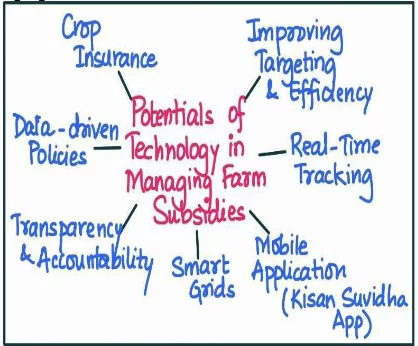Answer:
|
How to approach the question
- Introduction
- Write about direct and indirect farm subsidies in India briefly
- Body
- Write the potential of embedding technology missions in managing direct and indirect farm subsidies in India.
- Write about the challenges impeding full utilization of these technology missions.
- Write solutions to address these challenges and ensuring fair distribution and mitigating regional imbalances.
- Conclusion
- Give appropriate conclusion in this regard.
|
Introduction:
Direct farm subsidies in India aid farmers by reducing input costs like fertilizers, power, and water.
Indirect subsidies, on the other hand, involve support through minimum support prices (MSP), crop
insurance, and price stabilization, protecting farmers against fluctuations in market conditions. Farm subsidies constitute about 2% of India’s GDP.
Body
Potential of embedding technology missions in managing direct and indirect farm subsidies in India

- Improving Targeting and Efficiency: Technology missions can streamline subsidies by leveraging data analytics, AI, and blockchain. For instance, AI can predict subsidy needs based on crop patterns and weather forecasts, ensuring only eligible farmers receive help.
- Real-time Tracking: Geospatial technologies can monitor farms, enabling authorities to track subsidy utilization. This could minimize misuse or leakage of funds. For instance, drone technologies could verify the existence and condition of registered farmland.
- Smart Grids: Technology can aid in creating smart grids for electricity and water. These grids can monitor and manage resource distribution to reduce wastage, enabling optimal utilization of subsidies meant for power and irrigation.
- Mobile Applications: Farmers can receive real-time updates on subsidy disbursement, crop prices, and weather patterns through mobile apps. For instance, the ‘Kisan Suvidha’ app provides information about weather, market prices, and farm subsidies.
- Transparency and Accountability: Blockchain technology can provide a secure and transparent ledger for subsidy distribution, minimizing corruption and ensuring that funds reach intended recipients.
- Data-Driven Policies: Technology missions can generate significant agricultural data, which could be used to design more effective and targeted subsidy policies. For instance, analyzing fertilizer use data can help revise fertilizer subsidy policies.
- Crop Insurance: Technology can play a role in optimizing crop insurance, an indirect subsidy. Satellite imaging can provide precise weather data, and AI can predict potential crop failures. These can improve the efficiency and accuracy of insurance payouts.
Challenges impeding full utilization of these technology missions
- Digital Divide: There’s a notable digital divide between urban and rural areas due to lack of reliable internet connectivity in many rural regions which can impede the effective functioning of digital platforms, reducing farmers’ ability to access real-time market data or digital subsidies. Example- By 2017, 41% of the farmers surveyed used Internet to obtain agricultural information.
- Technological Literacy: Many farmers still lack the necessary digital literacy to take full advantage of technology. Eg: the effectiveness of mobile applications like ‘Kisan Suvidha’ is limited if farmers aren’t skilled in using such platforms, leading to underutilization of these services.
- Infrastructure Issues: The adoption of advanced technology like IoT devices, drones, and satellite imaging requires robust supporting infrastructure. The lack of consistent electricity & network connectivity can make the implementation of these technologies difficult. Example- 91% of respondents said they face call drops problem, while 56% said that problem was severe in their case
- Initial Costs: The upfront costs of new technologies can be high, posing a significant barrier for small and marginal farmers. For example, precision farming tools that help manage resources efficiently might be beyond the financial reach of these farmers.
- Maintenance Challenges: Technical malfunctions in high-tech devices can be challenging to repair in remote regions. Eg: a malfunctioning IoT device in a remote village might remain unrepaired due to the absence of a skilled technician, impacting its utility.
- Policy Hurdles: Existing regulatory frameworks could hinder technology adoption. For instance, while drones can be instrumental in monitoring crop health, strict regulations around their usage can limit their potential in Indian agriculture.
Solutions to address these challenges and ensuring fair distribution and mitigating regional imbalances
- Enhancing Rural Connectivity: Bridging the digital divide requires significant investment in rural internet infrastructure. The BharatNet project exemplifies such an initiative, aiming to provide broadband connectivity to all rural households in India, enhancing the scope and reach of digital platforms.
- Scaling Digital Literacy Programs: Initiatives like Microsoft’s Project Sangam, which trains rural individuals in digital skills, serve as good models that can be replicated across different regions, equipping farmers to leverage technology effectively.
- Offering Subsidized Technology: The government could facilitate affordable access to advanced agricultural technologies by providing subsidies or low-interest loans for small and marginal farmers, thus levelling the playing field. Example- Rashtriya Krishi Vikas Yojana (RKVY)
- Developing Maintenance Services: Establishing a network of locally trained technicians can ensure efficient repairs of high-tech devices. HCL’s IT services in rural areas, for instance, offer a good model for maintaining digital systems.
- Encouraging Community Engagement: Addressing fears and concerns through close interaction with farming communities can bolster technology adoption. Hands-on workshops and demonstrations can familiarize farmers with new tools and techniques.
- Revising Policies: Policy frameworks need to accommodate the growing role of technology in agriculture. For instance, revising the current drone regulations to be more liberal can pave the way for widespread use in farming.
- Adopting Phase-Wise Implementation: Scaling new technologies can be achieved through phased implementation, initiating from pilot areas and gradually expanding. The gradual digitization of land records across districts is an example of this approach.
Conclusion
Harnessing the potential of technology missions could revolutionize farm subsidy management in India. Overcoming present challenges will pave the way towards a future where subsidies are efficiently utilized and equitably distributed, fueling a new era of agricultural prosperity and sustainability in the country.
To get PDF version, Please click on "Print PDF" button.


Latest Comments